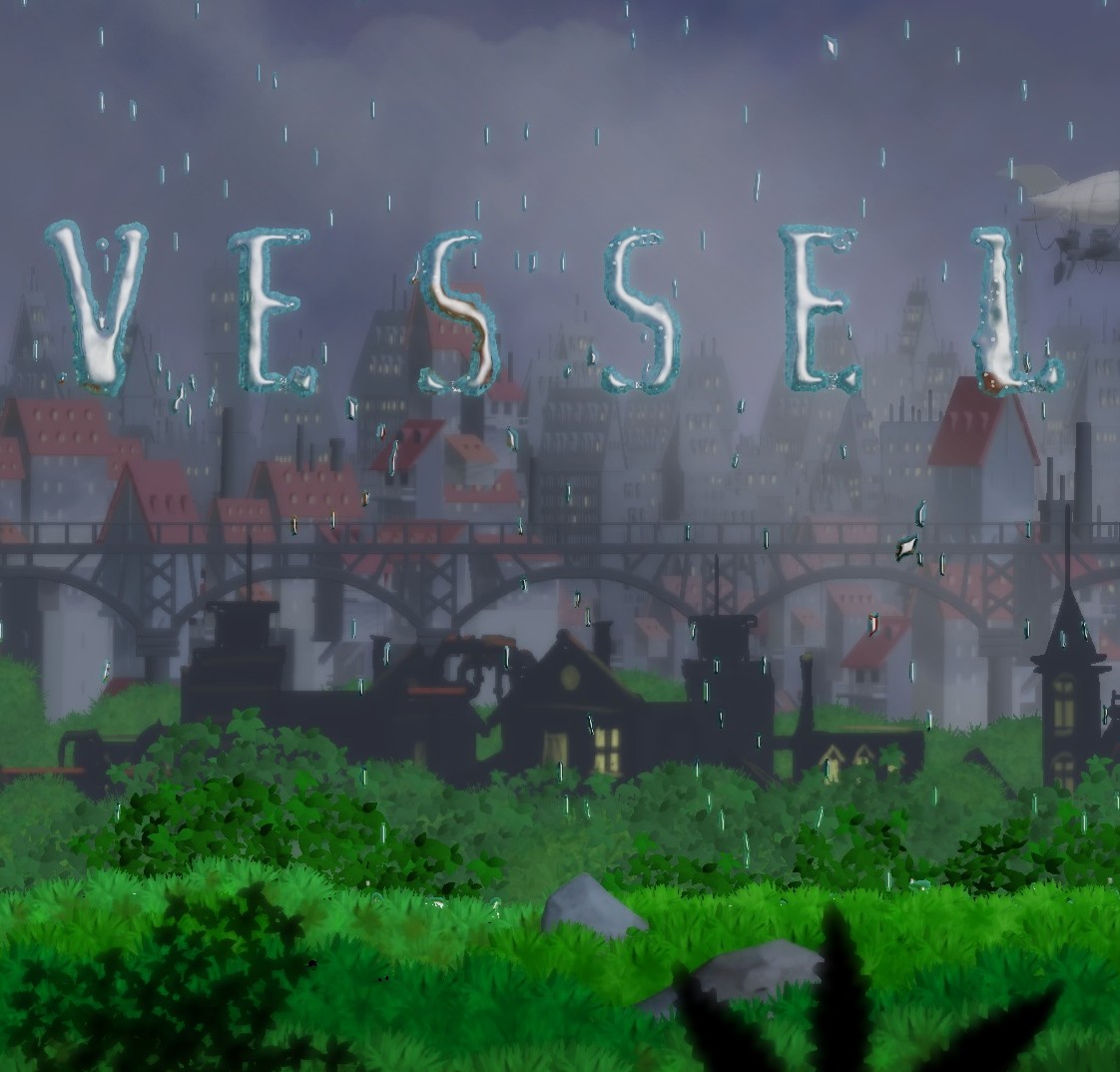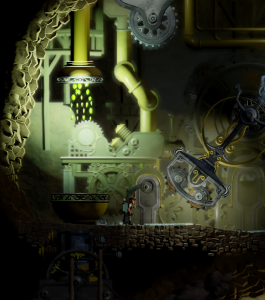Do Fluros dream of liquid sheep? That is the unanswerable question posed in Strange Loop Games’ new title, Vessel. Combining a run-n-gun/puzzle-platformer game style with an engine built to model particle liquid effects, this game has you working out how to activate the various buttons and levers required to fix each or the 8 broken machines in this Bioshock-esque universe.
You begin the game with a cutscene, stills and text pieced together in true indie game-fashion. The opening movie tells the story of a well-meaning scientist who creates a race of unintelligent creatures known only as the Fluros. These passive creatures would do humanity’s dirty work: The hard and dangerous jobs. After a few years of idyllic, virtually free labour, people began to notice something. Changes in the way the entirely liquid-based Fluros act began to become apparent. New forms of Fluros began being sighted in the bowels of the machinery. Some were not as friendly as their engineered counterparts, and problems began to arise. The factory was shut down and our hero, the aforementioned scientist, is called in to discover the problem with the Fluros and fix the issues so that life can go on once again as normal.
The way this game is feels, with it’s rooms and caverns filled with secret passageways and inaccessible rooms, is often reminiscent of Braid or Myst, as if a deeper meaning could be found in the basic gameplay and images left behind your eyes well after you lay down for bed. The lighting is eerie in certain parts, leading you to believe that there must be some mechanical value to the sparse, lonely lamp hanging from the overhead trolley that you are trundling along on. Unfortunately, Strange Loop missed the boat on that particular mechanic and chose instead to focus more heavily on liquid-physics and lever-pulling. The liquid itself is peculiar, looking more like balls rolling around on the screen than real liquid. I would be hesitant to call this a liquid-physics based puzzle-platformer if the designers didn’t coin it so. It looks more like sophisticated but coarse (as opposed to fine) particle-physics. The environments themselves are in a style that speaks to steampunk, industry, and dungeon-delving. The protagonist seems cut straight from Thomas Dolby’s mythical dystopia, while the abandoned factories seem to scream the word “alone” in the space between our hero’s footsteps, and the caverns drip with water from the damp ceilings. The machines are another matter altogether. These hulking pieces of metal are very functional pieces used almost exclusively to propagate and enhance the gameplay. The steam collectors, iron platforms, and water spouts never seem to quite fit into the look of the environments, as if the rooms were made first and the puzzles built to fit the room, rather than the other way around. This particular phenomenon left me with a feeling that I felt while playing The Incredible Machine. I felt that I should be able to add and remove pieces of machinery at will, which of course would break every puzzle in the game.
The sound is really something else. Your overlarge boots loudly ring out in steel corridors and thud against wet dirt, your begoggled helmet bangs against the ceiling as you try to avoid ground-level lava in a low passageway, and the music.. Strange Loop really scored when they got Jon Hopkins (who worked on the sci-fi hit Monsters and with artists such as Coldplay, Brian Ino, and Imogen Heap.) He has created an original, haunting, full-length electronic album which is dynamically remixed into each puzzle and scene. Returning to themes from earlier levels and providing audio clues as to how to solve each problem that you encounter. If only life had such a soundtrack. The soundscape in this game is nearly perfect.
The main mechanics used in solving these puzzles are smart utilization of the Fluros, your extra hands, your super-soaker backpack/nozzle combo, and the Fluros seeds that you pick up along the way. Each Fluros (Fluro?) is made out of two pieces: 1) The liquid which makes up it’s bulk, and 2) the seed which directs it’s mass to do useful things. Liquid can be found nearly everywhere in this game, I never really found myself running out of water and the canister in my backpack was almost always full. The Fluros take on the properties of the liquid that they’re made out of. Water Fluros are your mainstay cheap labour, lava Fluros act in the same way as their watery brethren, but are much too hot to touch. If water and lava come together, they create great geysers of steam that can be used to power certain
machines. Some Fluros were not engineered by man and act in some strange ways. Predator Fluros will actively attempt to kill you, while one made out of globular fruit-flesh will attempt to assimilate more and more liquid until it reaches a critical capacity and dramatically explodes. Utilization of these various properties are one key to solving the various puzzles you come across. Another tool is your backpack. Made out of a canister and a nozzle, it looks very much like a self-contained fire-fighting tool, or a very primitive proton pack. This backpack has the ability, not only to shoot water, which is expected, but also to reverse the flow and suck up various kinds of liquids which can then be spat back out. This comes in handy from many different puzzles (shooting water down a drain so that it mixes with the lava below, creating enough steam to activate the collector above the chamber, for instance) but is also used as an offensive weapon against the lava Fluros when they are closing on you. A second or two of exposure to water will cool seeded lava enough to destabilize it’s body, crumbling it into a sad little pile with a doomed seed floating around in it. The seeds, yes! These products of high biological tampering are what are used to conform the water around them into a useful form. The friendly spheres with tentacles and legs are fairly fragile but used in almost every puzzle in the game, so you will learn that having an infinite supply of seeds is not only handy, but necessary. The seeds literally attract water in what was coined a “molecular attraction” by the developers. Not only does this make it easier to form Fluros, but you can also manipulate liquid even through walls. This mechanic is utilized sparingly but effectively in many different parts of the game, adding an unexpected element to a fairly simple puzzler.
The puzzles themselves are simple enough that you can retain their entirety in your working memory for days, even if you can’t make it back to the PC. I never lost any sleep going over them in my head, but I can say that coming back to a challenging screen that I’ve been thinking about and solving it nearly immediately is a very rewarding experience. The puzzles don’t ever get too hard, either. There wasn’t ever a point in the game where I scratched me head and saw no way to solve it. There was always some niggling clue (“if only I could figure out why this button is here” or “why does this door open?”) that kept me from giving up.
The replay of this game is hampered by the fact that once you know how to solve the puzzles, there is no challenge anymore, and therefor no satisfaction is gained in replaying the game. With 10-12 hours of gameplay, I would say that this game is priced perfectly at $14.99 on Steam and Strange Loop Games’ own website. I recommend this game to anyone who likedBraid for it’s gameplay elements or is looking for a concise, quirky puzzle experience.
There are plans for Vessel to be released on XBLA and PSN, though no timeline has been released for those iterations.
Buy the game for $14.99 on Steam, or a DRM-free version at Strange Loop Games.
** Originally published on levelsave.com **



No comments:
Post a Comment